
The OSIRA Lamp
The OSIRA electric discharge lamp is now being used extensively for public lighting schemes.
It is backed by extensive practical experience and is a throughly reliable product,
guaranteed by The General Electric Comapny, Ltd., and approved by experienced electrical engineers
and lighting authorities.
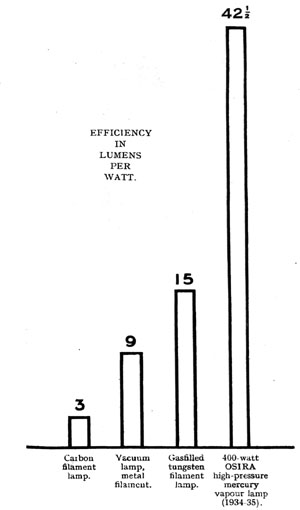
Diagram showing proportionate light output in lumens
per watt of OSIRA lamps and incandescent filament lamps.
Some general notes and technical practicalities of the OSIRA lamp will be found on pages
24-30. We shall be pleased to forward more detailed information on the lamp and its application
to those interested in special lighting problems.
The New Light Source
The OSIRA electric discharge lamp constitutes the most important recent advance in the technique of
light production.
In the past all practical illuminants have depended upon the radiation emitted from heated
bodies. The sun, the filament of an electric lamp, the gas mantle and the crater of a carbon
arc, all emit light because, and only because, they are extremely hot. There is a limit to the efficiency obtainable
from such sources; in a metal filament lamp, for example, as the melting point of tungsten is approached.
The case of electric discharge lamps is entirely different. The light is produced not because the
gas or vapour is very hot, but because it is "excited" electrically. The limits of efficiency
are greatly in excess of those obtainable from heated bodies. The OSIRA lamp gives is light
by the discharge of electricity through a mixture of gases, which includes mercury vapour
at a higher pressure than has hitherto been practical. The lamp can be run directly off
ordinary A.C. mains, the only essential auxiliary being a series impedance.
Development And Trials
The OSIRA lamp was invented and developed in the Research Laboratories of The General
Electric Company, Ltd. at Wembley, Middlesex, and was first put into operation on June 22nd,
1932, for street lighting in the G.E.C. installation in East Lane, Wembley. This was the first public
lighting installation in the world to employ lamps of this type, and they may be said to have
left the laboratory stage at this time.
The First Service Installation
The outdoor trials in East Lane were followed by a complete installation operating under
normal electric conditions on the Watford Road, Wembley. These 46 units were erected by
The North Metropolitan Electric Power Supply Company for the Wembley Urban District Countil
and were put into service at the beginning of March 1933. The whole of the equipment operated satisfactorily from
the outset, thus providing that OSIRA lamps were practical, reliable, and efficient under
service conditions.
Practical Applications
The list of districts where OSIRA lamps have been specified for public lighting in conjunction
with G.E.C. lanterns and equipment is continually growing. Among pioneer installations of these lamps
are thjose at :-
| LONDON AREA |
Beckenham
Croydon
Deptford
Greeenwich
|
Kensington
Kingsbury
Kingston
Lambeth
|
Lewisham
Maldens and Coombe
Palmer's Green
Wembley
|
Willesden
Wood Green
Woolwich
|
HOME COUNTIES |
Bournemouth
Brentwood
Dover
Eastbourne
|
Harwich
Ipswich
Norwich
Plymouth
|
Portsmouth
Reading
Romford
Southampton
|
Tunbridge Wells
Ware
|
BIRMINGHAM AREA - - - BIRMINGHAM |
BELFAST AREA - - - BELFAST |
CARDIFF AREA - - - Bridgend and Newport |
GLASGOW AREA - - - Buckhaven and Edinburgh |
MANCHESTER AREA |
Birkenhead
Blackburn
Blackpool
Burnley
|
Liverpool
Manchester
Oldham
Prestwich
|
Rochdale
Skipton
Stockport
Stretford
|
Warrington
Wigan
Worksop
|
NEWCASTLE AREA |
Bridlington
Chester-le-Street
Darlington
|
Hull
Middlesbrough
Seaham Harbour
|
South Shields
Stockton-on-Tees
Thornaby
|
Tynemouth
|
Many of these contracts were secured in competition with other forms of illuminant on
account of the increased visibility, more even lighting and lower cost as compared with the
rival systems.
PRESENT RANGE OF "OSIRA" LAMPS (July, 1935)
The original OSIRA lamp, first placed on the market early in 1933, had a rating of 400-watts,
and this wattage, given a light output equivalent to a 1,000-watt tungsten filament lamp,
has proved the most suitable for the lighting of roads carrying heavy motor traffic.
The introduction in 1934 of the 250-watt OSIRA lamp has enabled secondary roads to be
provided with the same quality of lighting as the main roads which employ the 400-watt lamp,
though at a a lower level of brightness.
The general construction and principles of the 250-watt OSIRA lamp are similar to those of the
400-watt, the light output being, for each lamp, roughtly 2½ tiems that which would be
given by a tungsten filament lamp of the same wattage. The principal characteristics of both lamps
are given in the technical notes.
G.E.C. Lanterns For OSIRA Lamps
The OSIRA lamp, being fitted with a standard G.E.S. cap, can be used in many existing fittings,
providing care is taken to protect the lamp from water drips or driving rain.
The source, however, differs widely in shape from that of a filament lamp, and if the
full efficiency of the OSIRA lamp is to be utilised special fittigns are essential.
The G.E.C. Laboratories and Illuminating Engieners have been engaged on this problem since
1932, and a series of special lanterns have been designed to give the most effective distribution
of light on the surface of the roadway. These lanterns are illustrated and described on pages
13-21. Further fittings are still under development.
Street Lighting
"Accident-proof" street lightin is needed to-day as never before. The OSIRA lamp puts
lighting of this class within the reach of all lighting authorities. The ability to
provide over double the light for the same energy consumption gives to the electrical
engineer an advantage which makes older forms of illuminant definitely obsolete.
It is gratifying to record in this connection that the numerous lighting authorities
who have so far completed or are installing OSIRA street lighting units ar eusing them, not to
reduce expenditure, but to improve on the existing installations.
The stirking improvement which the new lamp makes possible is borne out by the typical
photographs reproduced within this publication.
Realising the fact that, for the same light output, the OSIRA lamp consumes less than half
the wattage of the more familiar filament lamp, many Central Station Engineers may view with
misgiving the prospect of their public lighting load being seriously diminished.
Those able to look back on the introduction of the gas-filled tungsten filament lamp in place
of the vacuum lamp will remember that precisely similar fears were then entertained.
History as a habit of repeating itself, and history has shown that, so far from the lower
current consumption of the gasfilled lamp having resulted in a reduction of revenue,
the number of units sold for public lighting alone has increased from 49 million units
in 1921-22, to upwards of 180 million units in 1931-32, an increase in units used of over
250 per cent.
It is, therefore, safe to predict that the OSIRA lamp will be the means, not of reducing
the output of electrical energy, but of providing abdundant and "accident-proof" public
lighting at a price which puts it within the reach of every district.
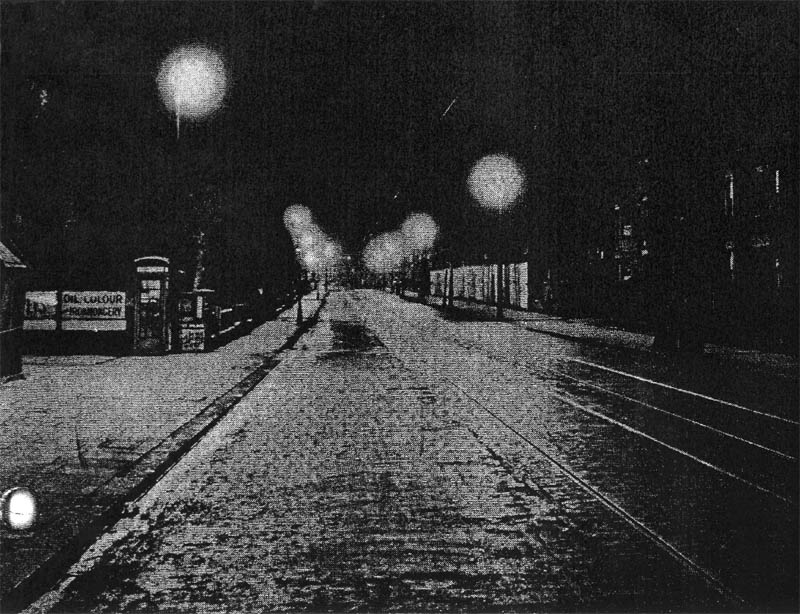
|
WOOD GREEN.
A MAIN ROAD ILLUMINATED BY 400-WATT OSIRA
LAMPS IN G.E.C. "WATFORD" LANTERNS.
160 SIMILAR UNITS ARE USED IN THIS AREA.
|
|
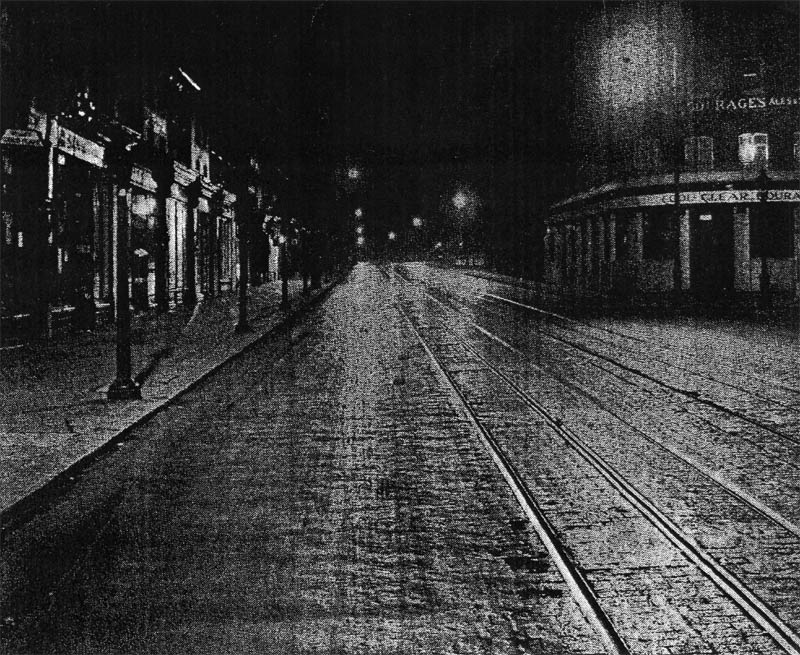
|
A MAIN ROAD IN DEPTFORD LIT BY
400-WATT OSIRA LAMPS AND
G.E.C. "LEWISHAM" LANTERNS.
OVER 100 OF THESE UNITS ARE USED
IN THIS INSTALLATION.
|
|
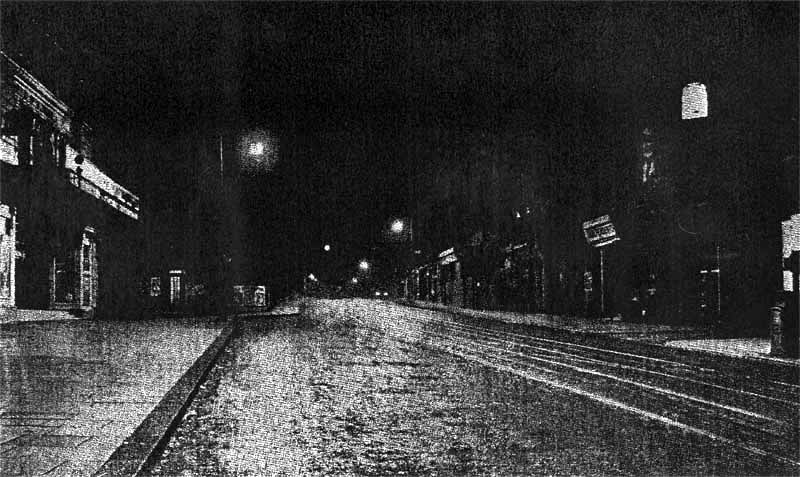
|
LONDON ROAD, LEWISHAM. ILLUMINATED BY 400-WATT OSIRA LAMPS AND G.E.C. "LEWISHAM" LANTERNS.
ABOUT 300 OSIRA UNITS ARE USED TO LIGHT THE MAIN THOROUGHFARES OF LEWISHAM.
|
|
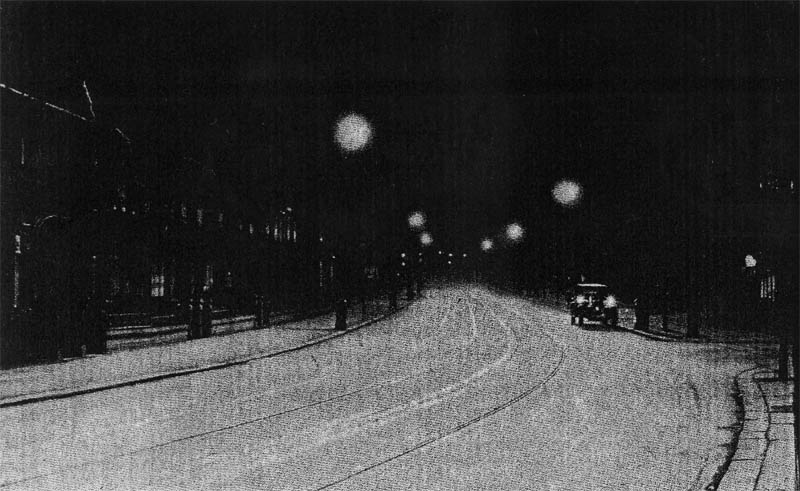
|
WHITEGATE DRIVE, BLACKPOOL. ILLUMINATED BY 400-WATT OSIRA LAMPS AND G.E.C. "WATFORD" LANTERNS.
200 OF THESE LAMPS ARE ALREADY INSTALLED AT BLACKPOOL.
|

|



